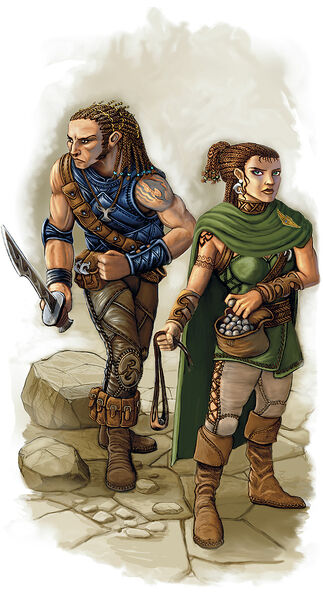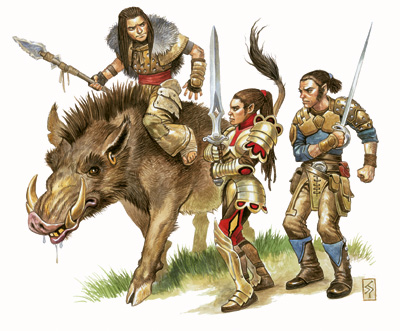STRONGHEART HALFLINGS
Regions: Luiren, Strongheart Halfling.
Strongheart halflings are, "like the ghostwise and lightfoot hin, native to Luiren." (RoF, 78) Unlike the ghostwise and lightfoot hin, the stronghearts decided to remain in their homeland after the events of the Hin Ghostwar: "The legacy of Chand, the strongheart war chieftain who galvanized his tribe against the threat of the feral ghostwise, lives on today in a nation that both reinforces and defies many of the expectations nonhalflings have of this race."
APPEARANCE: Strongheart halflings look very similar to lightfoot halflings, though the disciplined, stern-faced expression of a strongheart warrior is often startling to people more used to seeing the jovial grin of a lightfoot halfling.
PERSONALITY: The stronghearts are orderly and industrious. They build for stability, creating strong communities, and "fiercely defend their homelands against threats that their lightfoot kin would simply flee:" (FRCS, 17)
Northland humans familiar with the easygoing ways of the lightfoot halflings are surprised to learn that some halflings are capable of a warrior tradition and aren't afraid to show a hint of arrogance or confidence in their own abilities or strengths. Strongheart halflings enjoy athletic contests and value exceptional skills of all kinds. (FRCS, 17)
OUTLOOK: The average strongheart halfling's worldview is as follows:
Prior to the Hin Ghostwar, the stronghearts were, like their brethren, mostly a nomadic hunter-gatherer people. During the centuries that followed that terrible conflict, however, the stronghearts gravitated toward a more agrarian-based lifestyle centered around permanent communities. But if the communities were stationary, the stronghearts were not, moving from established community to established community.
This strange duality of nature, consisting of a desire to move about freely with a liking for permanent structures and settlements, has produced some unusual outlooks among the stronghearts of Luiren. Their viewpoint stresses cooperation above all other traits, and the ability to work as a team is the most valued behavior in their land. Cooperation transcends many boundaries in Luiren, and even strangers of whom the locals are suspicious can earn themselves considerable credit and tolerance by demonstrating a willingness to cooperate. (RoF, 78-79)
SOCIETY: The strongheart halflings have established their homeland in Luiren, and numerous, stable towns; and yet, they lead "a unique, semi-nomadic lifestyle, in which businesses, families, and even entire clans can move freely and independently from place to place within Luiren." (RoF, 79)
The combination of wanderlust with the desire for stability has creates a bizarre society in the eyes of many outsiders, who "find it difficult to comprehend how a society can enjoy such seemingly whimsical mobility while retaining any viable structure." (RoF, 79) And yet, "for their part, most of the strongheart hin cannot understand why anyone would want to tie themselves permanently to any one community or structure for their entire lives." (RoF, 79)
RELIGION:
The scrupulous stronghearts of Luiren take care to honor all the deities in the halfling pantheon, but their way of life reflects the influence of certain powers more than others. They do not favor any deities from other pantheons, and they actively discourage halflings from venerating the gods and goddesses of other races.
[...] Arvoreen enjoys the strongest worship from the stronghearts of Luiren. While the Luiren hin venerate all the deities of the halfling pantheon in their turn, they hold the Vigilant Guardian in very high regard. His simple dogma has almost become the de facto motto of the nation: "Vigilance against attack will protect the community. Prepare an active defense, drill continuously, and leave nothing to chance. Put down danger before allowing it a chance to rear its head." Clerics of the Wary Sword are among the nation's foremost religious, political, and military leaders. [...]
Strongheart druids and rangers frequently venerate Sheela Peryroyl, the Green Sister, and they encourage their fellow hin to be mindful of the need to balance their communities' expansion with the need to preserve nature. [...]
Yondalla, the Blessed One, is the most popular halfling deity after Avoreen among the stronghearts. Many of the subrace who dwell in Luiren find the dichotomy of her faith -- do not welcome violence, but defend the home and community fiercely -- to be reflective of the strongheart outlook. [...] (RoF, 79)
PLAYING A STRONGHEART HALFLING: Although no one can tell you how to design your character, here are some tips for getting started:
Stronghearts have relatively more clerics and martial characters (fighters, rangers, and paladins) than their lightfoot cousins, but the skilled rogue is still the most common character class among strongheart adventurers. Strongheart halflings can be tricky, clever warriors or glib negotiators -- or both. (RoF, 79)

